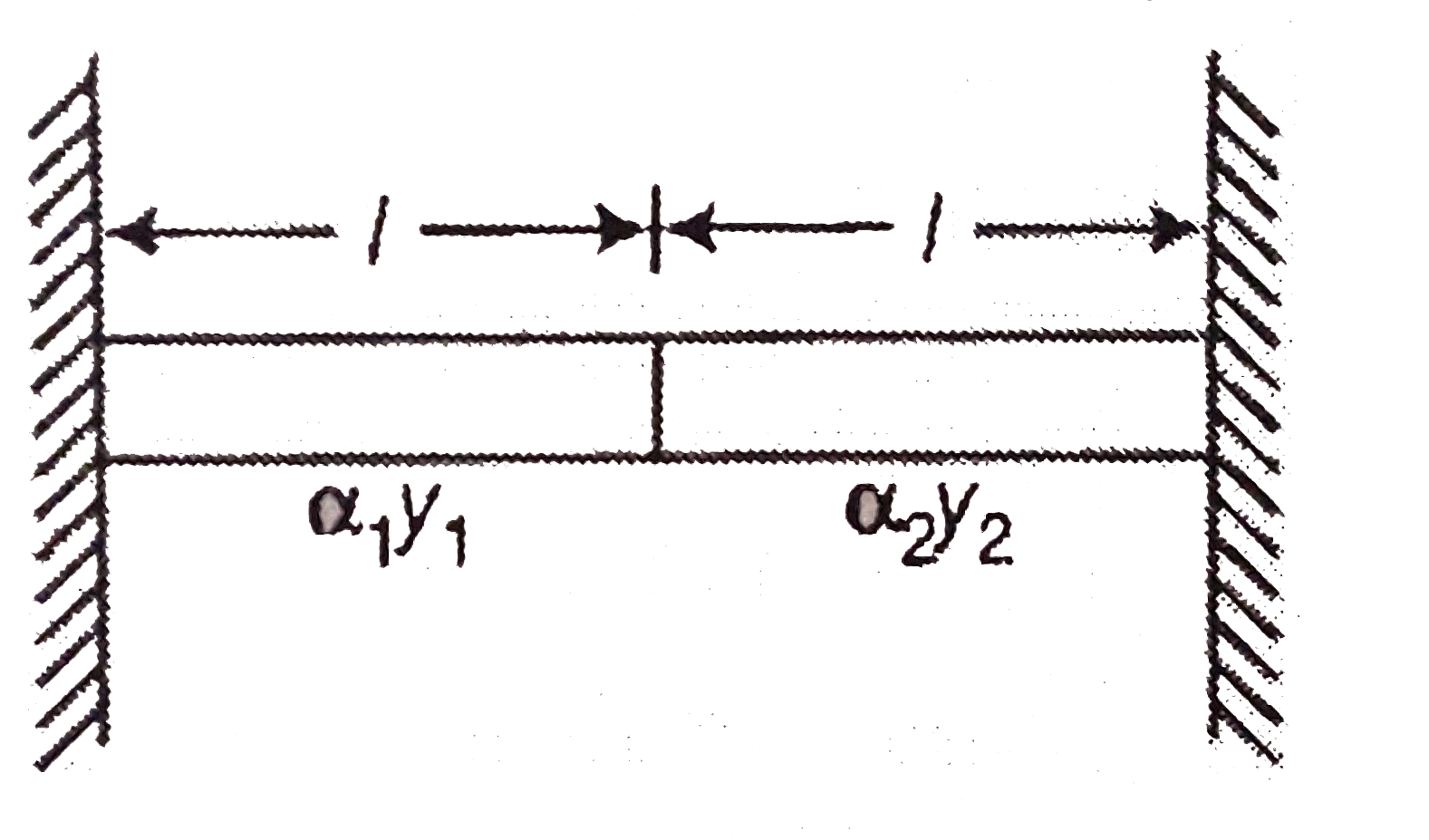Two rods are joined between fixed supports as shown in the figure. Condition for no change in the length of individual rods with the increase of temperature will be
(α1,α2= linear expansion coefficient
A1,A2= Area of rods
Y1,Y2= Young modulus )

A1A2=a1Y1a2Y2
A1A2=L1a1Y1L2a2Y1
A1A2=L2a2Y2L1a1Y1
A1A2=a2Y2a1Y1
Since tension is the two rods will be same, hence A1Y1αΔθ=A2Y2α2Δθ
⇒A1Y1α1=A2Y2α2
Topper's Solved these Questions
- TEST PAPERSBOOK - BANSALCHAPTER - TEST PAPERSEXERCISE - PHYSICS PART (A)
32 Videos
- TEST PAPERSBOOK - BANSALCHAPTER - TEST PAPERSEXERCISE - PHYSICS PART (B)
3 Videos
- TEST PAPERSBOOK - BANSALCHAPTER - TEST PAPERSEXERCISE - PHYSICS PART- C
4 Videos
- SEMICONDUCTORSBOOK - BANSALCHAPTER - SEMICONDUCTORSEXERCISE - CBSE Question
32 Videos
Similar Questions
Two metal rods are fixed end to end between two rigid supports as shown in figure. Each rod is of length l and area of cross-section is A. When the systeam is heated up,datermine the condition when the juncation between rods does not shift ? (Y1 and Y2 are Young's modulus of materials of rods, α1 and α2 are coefficients of linear expansion)
_S01_022_Q01.png)
View SolutionTwo rods of equal cross sections, one of copper and the other of steel, are joined to form a composite rod of length 2.0 m at 20∘C, the length of the copper rod is 0.5 m. When the temperature is raised to 120∘C, the length of composite rod increases to 2.002m. If the composite rod is fixed between two rigid walls and thus not allowed to expand, it is found that the lengths of the component rods also do not change with increase in temperature. Calculate Young's modulus of steel. (The coefficient of linear expansion of copper, αc=1.6×10−5∘C and Young's modulus of copper is 1.3×1013N/m2).
View Solution
Knowledge Check
The variation of lengths of two moles rods A and B with change in temperature is shown in figure . The ratio of αaαB is :-
_E01_013_Q01.png) A32B23C43D34
A32B23C43D34Two rods AB and BC of equal cross-sectional area are joined together and clamped between two fixed supports as shown in the figure. For the rod AB and road BC lengths are l1 and l2 coefficient of linear expansion are α1 and α2, young's modulus are Y1 and Y2, densities are ρ1 and ρ2 respectively. Now the temperature of the compound rod is increased by θ. Assume of that there is no significant change in the lengths of rod due to heating. then the time taken by transverse wave pulse to travel from end A to other end C of the compound rod is directly proportional to
_E01_086_Q01.png) A√l2Y1+l1Y2B2√l2Y1+l1Y2C√l1Y2+l2Y1D√l2Y1−l1Y2
A√l2Y1+l1Y2B2√l2Y1+l1Y2C√l1Y2+l2Y1D√l2Y1−l1Y2Two metal rods are fixed end to end between two rigid supports, as shown in figure. Each rod is of length l and area of cross-section is A. When the system is heated up, determine the condition that the junction between rode not shift. [Given Y1andY2 are Young's modulus of materials of teh rods while α1andα2 are coefficient of linear expansion]
 Aα1Y2=α2Y1Bα1Y1=α2Y2Cα1=α2DY1=Y2
Aα1Y2=α2Y1Bα1Y1=α2Y2Cα1=α2DY1=Y2
Two steel rods and an aluminium rod of equal length l0 and equal cross section are joined rigidly at their ends as shown in the figure below. All the rods are in a state of zero tension at 00C. Find the length of the system when the temperature is raised to θ. Coefficient of linear expansion of aluminium and steel are αaandαs respectively. Young's modulus of aluminium is Ya and of steel is Ys.
steel
Aluminium
Steel

View SolutionTwo metal rods are fixed end to end between two rigid supports, as shown in figure. Each rod is of length 'l' and area of cross-section is A. When the system is heated up, determine the conditioin whenthe juction between rods does not shift.
[Given, Y1 and Y2 are Young's modulus of materials of the rods, α1 and α2 are coefficient at linear expansion.

View SolutionTwo rods of different materials having coefficient of thermal expansion α1,α2 and young's modulii Y1,Y2 respectively are fixed between two rigid massive walls. The rods are heated such that they undergo the same increase in temperature. There is no bending of rods. If α1:α2=2:3, the thermal stresses developed in the two rods are equal provided Y1:Y2 is equal to
View SolutionTwo rods of different materials having coefficients of thermal expansion α1,α2 and Young's Moduli Y1,Y2 respectively are fixed between two rigid massive walls. The rods are heated such that they undergo the same increase in temperature. There is no bending of the rods. If α1:α2=2:3, the thermal stresses developed in the two rods are equal provided Y1:Y2 is equal to
View SolutionThe coefficient of linear expansion of a rod is α and its length is L. The increase in temperature required to increase its legnth by 1% is
View Solution
